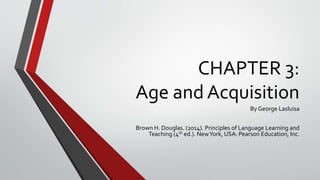
Age and Acquisition
- 1. CHAPTER 3: Age and Acquisition By George Lasluisa Brown H. Douglas. (2014). Principles of Language Learning and Teaching (4th ed.). NewYork, USA: Pearson Education, Inc.
- 2. Hemispheric Lateralization • When the human brain matures, it lateralizes functions to the right and left hemispheres. • Language functions appear to be controlled by the left hemisphere. • When does lateralization take place? • Eric Lenneberg (1967) from 2 years to puberty. • Thomas Scovel (1969) plasticity prior puberty allows to aquire 1st and 2nd language. • Norman Geschwind (1970) earlier than puberty. • Stephen Krashen (1973) around age of five. Left hemisphere Right hemisphere
- 3. BiologicalTimetables Early ages: Lower-order processes like pronunciation. Late maturation: Higher-order language functions like semantic relations • Aspects of a second language are learned optimally at different ages:
- 4. Right Hemispheric Participation • Obler (1981) exposed significant right hemisphere participation particularly in the early stages of acquiring a second language. • Strategies of guessing meanings, use of formulaic utterances, etc. • Genesee (1982) right hemisphere is involved in complex language processing, opposed to Obler in early language acquisition. • Obler later found in a study that adults can also be benefited from the right hemisphere. • Jane Hill (1970), non-Western societies had evidence that adults can perfectly acquire a second language. • Sorenson (1967), two dozen languages are spoken in the region of theTukano culture. Young people speak 2 or 3 languages and acquire more while getting older. Atropological Evidence
- 5. To consider age on second language acquisition.We must focus on the Operational Stage.When a person is capable of abstraction, formal thinking. • Ellen Rosansky (1975), language acquisition takes place when children are ‘centered’. • The lack of flexibility improves focus on one dimension at a time. • Children acquire language when they are not aware of societal values and attitudes. • Logical and anecdotal counterevidence Logical Superior intellect facilitates complex activities. Anecdotal Successful adult language learners were fully aware of their learning process and looked for extracurricular learning tolos.
- 6. Lateralization hypothesis • While becoming adults, the left hemisphere becomes more dominant. Left and Right hemispheres. Analytical and intelectual functions Emotional functions Rote and Meaningful Learning Children Practice and imitation are meaningful learning. Adults Developing greater concentration is a good ability for rote learning.
- 7. Piaget Equilibration • Cognitively talking, it is continuously moving from estates of doubt to states of solutions.To look for a way to stay equilibrated. • Disequilibrium may provide motivation for language acquisition until reaching equilibrium in adulthood and acquiring the needed language. • Children are indifferent to contradictions, intellectual growth makes them aware of these ambiguities. • At the age of 14 or 15 youngsters are aware and intolerant to contradictions making overwhelming the acquisition of a new language.
- 8. • Humans are emotional creatures. • Very young children are highly egocentric.The world revolves around them. • When children grow they are more self-conscious and they seek to define and understand self-identity. • In preadolescence, develop consciousness means being aware and conceive insecurity.They develop inhibitions fearing to expose too much. • At puberty, inhibitions grow to physical, cognitive and emotional changes. This affects their ego. • Ego is linked to our mother tongue, a second language does not mean any threat to ego for children. Affective domain includes Empathy Self-esteem Extroversion Inhibition Imitation Anxiety
- 9. Other affective factors. • Ego identification, the study of a second language as the acquisition of a second identity. • Attitudes in language learning. A young children without notion of culture, ethnic groups, stratus, language, etc. are better language learners due to the lack of ideology and stereotypes. • Peer pressure, if adults can understand a second language speaker, they can provide positive feedback and encourage them.
- 10. Billingualism • Coordinate billinguals, children that learn 2 languages in separated contexts. • Compound billinguals, they have only one meaning system for both languages. • Code-switching, inserting words from one language to the other one. • Children learning a second language use a creative construction process. Just like the first language. • The acquisition of morphemes was the same between English first language learners and English second language learners. Eleven morphemes. • Some argued that eleven morphemes are just a small part of English syntax. Order of acquisition
- 11. Interference Between first and Second Language • Linguistic and cognitive processes of second language in general are similar to first language in children. • Mistakes are made by intralingual strategies instead of interference errors from the first language. In Adults • Adults learning a second language, manifest some of the same errors of children in their first language. • The first language is used to bridge gaps of the second language. • The first language is a facilitating factor instead of a interfering factor.